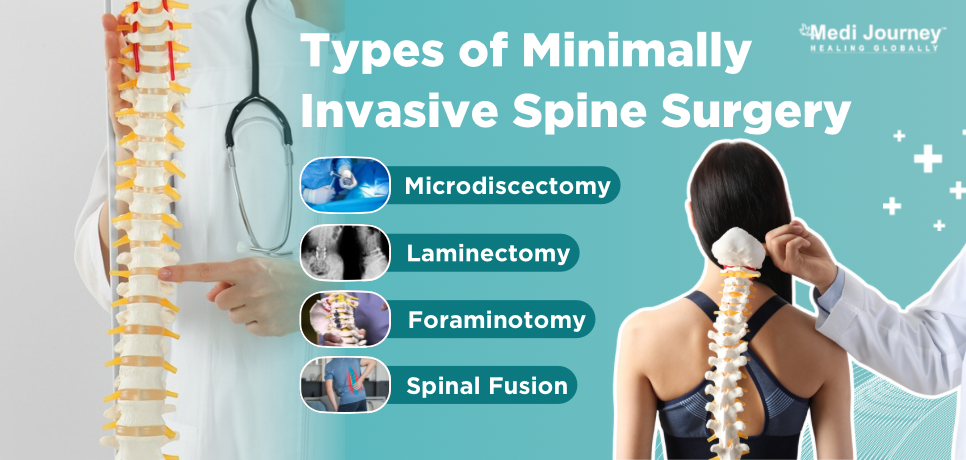The Role of Government Initiatives in Promoting Medical Tourism in India
 02 April,2025
Read More
02 April,2025
Read More
Enquire now in case of any assistance needed
 03 May,2024
03 May,2024

Undergoing spine surgeries was a traumatic experience back in the day. It was rightly so due to the low success rates and higher postoperative complications. But that’s not the scenario anymore. Today, approximately 3 to 5 million spine surgeries are done annually worldwide.
One of the primary reasons patients have started trusting surgeons with spinal procedures is the improvements in surgical techniques. Minimally invasive spine surgeries have revolutionized the field of neurosurgery. Surgeons make an incision smaller than 2 cm, leaving the surrounding muscles and soft tissues unharmed. It helps patients recover quickly and minimizes the risk of complications.
Patients can now expect a success rate of 70 to 90% with minimally invasive spine surgeries. Read the blog further to learn about the procedure, suitable candidates, and benefits.
Minimally invasive spine surgery (MISS) involves making small incisions in the skin rather than a single large incision, which is typical of open surgery.
During open surgery, a significant amount of muscle and surrounding soft tissue may be moved or removed from the bone to allow the surgeon a clear view of the surgical site. It causes more muscle damage and pain after surgery.
In contrast, minimally invasive surgery involves using a small metal tube or endoscope inserted through the small incisions to allow the surgeon to work through a smaller operative field. This results in much less damage to muscles and soft tissues than a single long incision.
Minimally invasive spine surgery (MISS) is a better option than traditional open spine surgery and offers several benefits. The main differences between MISS and open spine surgery are as follows:
Not everyone with back pain requires surgery. The primary criteria for determining whether you're a suitable candidate for MISS are the same as those for traditional open surgery.
Your healthcare provider may recommend spine surgery when nonsurgical treatments, such as physiotherapy and medications, have not relieved the symptoms caused by your back problem. If you are suffering from excruciating pain, spine surgery might fix the problem.
Additionally, your doctor will consider surgery if they can identify the source of back pain, such as spinal stenosis or a herniated disc.
However, not every disease can be treated with minimally invasive spine surgery. The surgeon will advise spine surgery only if you have a condition that MISS may help with. This includes disorders such as:
If you're considering spine surgery, it's essential to ask your surgeon if minimally invasive spine surgery (MISS) is an option. Keep in mind that not all types of spine surgery can be performed with MISS, and not all hospitals are equipped for MISS.


Keyhole or minimally invasive spine surgeries offer several benefits over traditional open spinal procedures. Some of these are –
MISS has gained significant popularity in recent years because of these advantages. If you are fascinated with benefits such as fewer postoperative complications and faster recovery, visit a spine surgery hospital today!
There have been significant breakthroughs in traditional spine surgeries. With the success of minimally invasive spine surgeries, researchers are now trying to improve the procedure further. Some of the advances in minimally invasive spine surgery are –
In conclusion, minimally invasive spine surgery (MISS) has revolutionized the field of spine surgery. MISS offers significant advantages over traditional open spine surgery with smaller incisions, less muscle disruption, and faster recovery times. If you're suffering from chronic back pain that hasn't responded to conservative treatments, talk to your doctor to see if MISS might be a suitable option for you. Remember, timely diagnosis and treatment are critical to a successful outcome. Schedule a consultation with a spine surgeon today to discuss your treatment options.
Doctor of Pharmacy
Dr. Deepanshu Siwach is a skilled clinical pharmacist with a Doctor of Pharmacy degree.?He has 4+?years of experience and has worked with thousands of patients. He has been associated with some of the top hospitals, such as Artemis Gurgaon.
A renowned Neuro-spine Surgeon, Dr. S K Rajan, has successfully performed over 3000 surgeries, including intricate spine cases. With over 25 years of experience, his expertise lies in minimally invasive (keyhole) spine surgery, Craniovertebral junction (...
Senior Consultant
Medical Oncologist
Nanavati-Max Super Speciality Hospital, Mumbai
Book Appointment WhatsApp UsSenior Director
Gynecologist and Obstetrician, IVF Specialist
Max Super Speciality Hospital, Shalimar Bagh, New Delhi
Book Appointment WhatsApp UsSenior Director
Gynecologist and Obstetrician, IVF Specialist
Max Smart Super Speciality Hospital, Saket, New Delhi
Book Appointment WhatsApp UsSenior Director
Gynecologist and Obstetrician
Max Smart Super Speciality Hospital, Saket, New Delhi
Book Appointment WhatsApp UsSenior Director
Gynecologist and Obstetrician
Max Smart Super Speciality Hospital, Saket, New Delhi
Book Appointment WhatsApp UsSenior Director
Gynecologist and Obstetrician
Max Smart Super Speciality Hospital, Saket, New Delhi
Book Appointment WhatsApp UsFill up the form and get assured assitance within 24 hrs!
The Art of Effective Communication
 24 January,2025
Read More
24 January,2025
Read More
Trusted by Patients
"I am Asim from Bangladesh and was looking for treatment in India for neuro. I visited many websites to get the complete information regarding the treatment but I was not satisfied as I was getting confused. In the meanwhile, one of my friends suggested I seek help from Medi Journey as he experienced his medical journey very smoothly and was satisfied with it. They have filtered the top 10 doctors as per experience, the success rate of surgery & profile, so it helps us to choose the best treatment in India. "
"For my knee surgery, Medi Journey guided me to BLK Hospital where I received exceptional care. The team's support and the expertise at BLK Hospital exceeded my expectations. Thank you Medi Journey for making my medical journey stress-free. "
"I came from Iraq for my granddaughter's eye surgery in India facilitated by Medi Journey, due to critical cases they advised us to get a second opinion from the different hospitals before going to surgery. Finally, we went to Fortis Escort Hospital, which helped us to get more confidence for diagnosis. Fortis Escort Hospital has the best eye surgeon team with the latest instruments. Thanks to all team members for providing a high-quality treatment in India at an affordable cost. "
"I came for my hair transplant in India, before coming I was so confused about choosing the best clinic and surgeon for me. But thanks to God one of my friends had a hair transplant in India through Medi Journey. He recommended me to go with them. I am completely happy with my experience with them. They were always very fast in their responses to me. the success rate of my hair transplant surgery is 100%."
"Artemis Hospital, suggested by Medi Journey, turned out to be a great choice for my treatment. The personalized assistance and medical care were exceptional. I'm grateful to Medi Journey for guiding me to a hospital that perfectly matched my needs. Highly recommended! "
"I came from Afghanistan for my treatment in India at Jaypee Hospital, Noida. I had a fantastic experience with Medi Journey. Kudos to them for their incredible support during my medical journey. They not only took care of all the logistics but also connected me with a fantastic healthcare team. Efficient, caring, and highly recommended for a hassle-free medical tourism experience."
"I am Adam from Kano, Nigeria, one of my friends from Nigeria was facilitated by Medi Journey, and he recommended us to go with them. I sent my all reports to them and within 48 hours they reverted with 4 options from different hospitals. They helped me to get a Visa letter from the hospital, arrange pick-up from the airport, and book a hotel for me. Their team is very honest and throughout our stay in India they are with us they are caring for us like his family members. BLK Hospital is the best hospital in India with a top surgical oncologist surgeon team, a very advanced OT, and a Radiotherapy department. I wish more success to Medi Journey. "
"Great experience at the Max Hospital for my spine surgery and was successfully done. I thank my neurosurgeon and his entire team. I recommended all of my country's people to Medi Journey for treatment in India, they choose the best hospital, the best doctors, and the best cost for patients."
"I came to India from Dhaka, Bangladesh for my father-in-law's cardiac surgery at Fortis Hospital. I was confused about choosing the best surgeon for him before coming, but their team helped me to choose the best hospital and best cardiac surgeon in India with very good cost and 100% success rate of surgery. I am very happy with the services, really they make my journey so comfortable that make me feel at home. Thanks again and I like people to choose "Medi Journey" as your travel guide. "
"I am Mohammad from Bangladesh came to India for my general health checkup. Medi Journey offers me the complete package including Pick-up from the airport, hotel services, and 24-hour assistance. They guide you to choose the best hospital in India, the best cost of treatment with top-most doctors and give you complete information about hotel booking, and pick-up from the airport before coming to India They have the best team to help. Always choose Medi Journey for your treatment in India."





